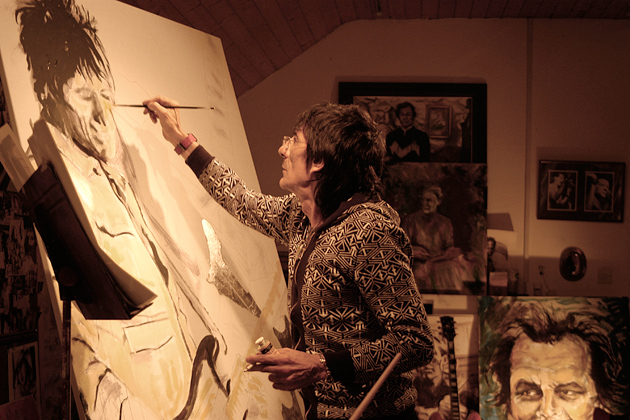
Twenty-five years ago this month, one of the first exhibitions of rock ’n’ roll art displayed in a museum opened in Bridgeport, Conn. Among the concert photographs, tee-shirts, album covers, and electric guitars displayed on the walls of what is now The Discovery Museum were the works of musicians known to be accomplished artists, such as John Lennon and Joni Mitchell.
The exhibition also featured line drawings and broad-stroked, colorful paintings by a musician-artist then less widely known for his art, guitarist Ronnie Wood of The Rolling Stones.
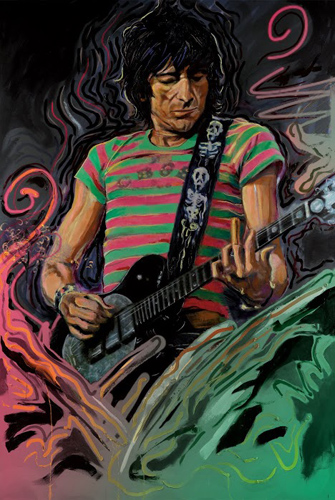
Today Wood’s paintings, drawings, and prints are regularly exhibited in museums and galleries around the world, and Liberty & Co., the London-based luxury clothier, has produced a line of clothing based on his art. On Friday, March 28, “Ronnie Wood: Art and Music,” an exhibition of paintings, lithographs, and pen and ink drawings by the guitarist, opens at The William Benton Museum of Art at UConn.
Wood grew up in a house filled with music played by his family, particularly his father and two older brothers, whom he followed to Ealing Art College in London after earning prizes for his drawing and other artwork.
“Ealing was the right school for me because, after music, I was always drawing while I was growing up,” Wood writes in his 2007 autobiography, Ronnie (St. Martin’s Press 2007), which contains his original drawings and portrait sketches. “Art was the most fun I ever had in school. We studied technique, colour, texture, and line, and that got me started reading books about artists, which is how I discovered Picasso and Braque. It was a very exciting time, but then these were the early 1960s and things were changing rapidly.”
Wood also writes that as a youngster he would send his drawings to the BBC art show “Sketch Club,” which showed some of the art submitted during the program. He won a prize for one of his submissions.
“I won the show’s main prize for a picture of an audience in the cinema, shocked and scared, looking at them from the screen out, as they reacted to a horror film,” he recalls in the book. “Winning that prize got my drawings into an exhibition and that was my awakening to art. I sometimes look back to this picture as the seed to both the worlds I ended up in. Depicting an audience in shock and awe meant my two worlds of art and performance came together in this little picture and preceded my night and day jobs.”
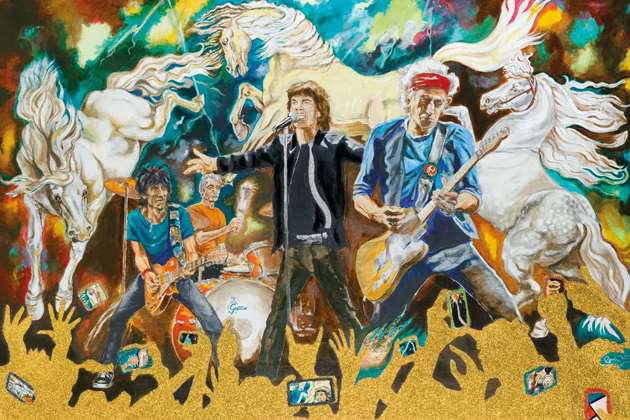
The number of other prominent musicians who also became known as artists – such as Miles Davis, David Bowie, Grace Slick, Freddie Mercury, and Jerry Garcia – raises the question of whether there may be a link between musical and artistic creativity.
“Understanding how music and art as different forms of expression originate within the same individual is an unexplored frontier” in neuroscience, according to Ed Large, professor of psychology in the College of Liberal Arts and Sciences, who studies how humans process music.
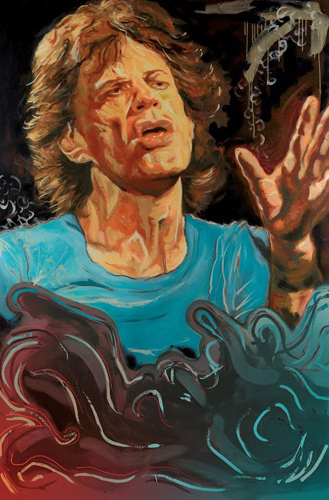
“Creativity is one of the hardest things to study,” Large says. “When you want to understand the brain, you have to replicate the same stimulus over and over; that’s just the opposite of what creativity is. It’s going to be a while before we understand anything about the creative process from that standpoint.”
Large says music stimulates the brain in a way very different from vision: “The sound of music stimulates the brain at frequencies in which the brain normally works. Light stimulation is very different. However, I know a lot of musicians who also do other forms of art like painting or drawing. I don’t think it’s uncommon. There is a creative sensibility.”
Wood’s musical rise to prominence began in 1969 when he and vocalist Rod Stewart performed with the Jeff Beck Group. The guitarist and vocalist later formed a band that would be called Faces, which had a chart hit in both the United States and England with the song “Stay With Me.”
By 1975, Wood had become close to his longtime friend, Stones’ guitarist Keith Richards, and he was invited to tour as the second guitar with The Rolling Stones when Faces were not performing. Early in 1976, Wood was invited to join the Stones permanently after Faces broke up.
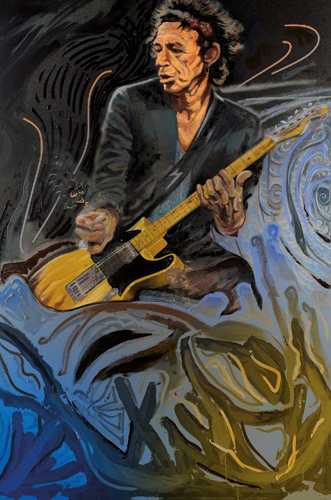
As a member of what has been called “The World’s Greatest Rock ’n’ Roll Band,” Wood’s public profile grew, and in 1987 the San Francisco Art Exchange, known for its exhibitions of rock art and photography, featured the first gallery exhibition of his art. Since that time, his work has been exhibited in New York and London, among other major cities, and at the Rock and Roll Hall of Fame and Museum in Cleveland, Ohio.
In 2003, theater producer and composer Sir Andrew Lloyd Webber (“Jesus Christ Superstar,” Phantom of the Opera,” and “Cats”) commissioned Woods to create a group portrait of notable contemporary British personalities set in a popular London restaurant, the Ivy.
“He arranged for 30 of the Ivy’s regulars to tell him who they’d like to sit next to for lunch, and that formed the basis of the painting,” Woods says in his book.
The painting, “The Ivy,” is hung in the Grand Saloon Bar of the Theatre Royal Drury Lane and includes Wood’s portraits of the models Kate Moss and Naomi Campbell, musicians Mick Jagger and Elton John, and author Salman Rushdie, among others.
“Ronnie Wood: Art and Music” will be on display from March 28 through Aug. 10 at The William Benton Museum of Art at UConn, 245 Glenbrook Road, Storrs. For more information, go to www.thebenton.org/



